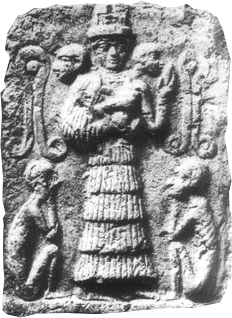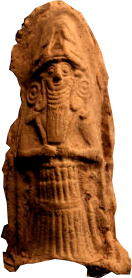Ancient Psychedelia: Alien Gods & Mushroom Goddesses
Online Book - Chapter 8, Page 108
Back to Online Book Mainpage / Next Page (Chapter 8, Page 109)
Many ancient depictions of Anu and the whole Sumer pantheon have them depicted in these mushroom styled dresses and mushroom shaped heads (22f).   R: (22f) Anu
|
All of the male gods evolved from female goddesses or feminine deities. The Sumerian god Anu was a masculinization of the name Anna-Nin, aka Nanna, who has been identified with Ana-hita, the Persian goddess by at least one scholar. (29) She was called Anaitis by the Greeks and the Persians called her Anahid, the same name they gave to the planet Venus. As well, the Sumerian goddess Belili was made a male god by shortening her name to Bel (Marduk), the Babylonian god. (30) Although it has been claimed that one of Ninhursag’s images is that of a serpent, I have yet to find this imagery anywhere. In every depiction I have seen, the gods were depicted as people though it’s certainly possible one of her animals was the serpent. (31) In Sumer, Dam-kina was the “Lady of the Earth” or “that which is down below,” who was married to Enki, the god of the waters. (32) Ninurta, Ninib (Ningursu) was the son of Enlil, a divinity of agriculture, a “lord of the fields.” As Ningursu, his spouse was Gula, and together they were a pair of healing divinities who saved their suppliants from disease and death. Ninib dispensed justice as well. (33) Interestingly, in Hebrew, the word “geula” means “redemption.” He was invoked in magic spells to ward off danger, and the demons of disease. He was later represented as a warrior with wings, a bow and arrows, and a mace that we are told is meant to represent speech and reason. By the 2nd millennium BC, he had the full status of a war god in the Babylonian work, The Epic of Anzu. Despite this later change, he continued to be associated with agriculture. (34) Ninib-Ningursu may be a modified Enlil-Ea, all of whom are wind, rain and storm deities of a sort. From The Journal of the Society of Oriental Research we read: “The storm-cult of Lagash was a descendant through Nippur, of the water cult of Ea. Nina (the Daughter of Eridu), who was the sister of Ningursu, was also the sister of Ea. Nina was the giver of oracles, which were associated with the water cult.” (35) Anzu was one of the Babylonian lesser deities, a monster conceived by the fresh waters of the Apsu and the earth, depicted as a lion-headed eagle who could breathe fire and water. In a book by Austen Henry Layard titled Monuments of Nineveh (2nd Series, 1853), there is an image of a stone stele depicting Ninurta casting a thunderbolt at Anzu while pursuing him for stealing the tablets of Destiny. Ninurta’s bird-like wings and style of clothing look very similar to Marduk. (26) When God was a Woman (27) ibid, p. 219 (28) The Great Mother, p. 135-6; Tr. Speiser in Pritchard, Ancient Near Eastern Texts, pp. 99f (29) J. Przbuski, Revue de l’ Histoire des Religions (1933) (30) The White Goddess, p. 371 (31) The Serpent and the Goddess, p. 8 (32) The Cult of the Mother Goddess, p. 233 (33) Healing Gods, p. 126; Jastrow, Civilization, p. 199 (34) In the Wake of the Goddess, p. 43; (https://www.ancient.eu/Ninurta/) (35) Journal of the Society of Oriental Research, Vol. V., Samuel Mercer, 1921, P. 58 |
Go Back to Page 107